TEAS TEST 6 QUESTIONS AND ANSWERS (RATED A)
Document Content and Description Below
1) When does meiosis take place? Human females: From 3 months of age prenatal (in the womb) until menopause (40's to 50's) Human males: From puberty (12-13) until death 2) Where does meiosis ta... ke place? In the gonads: ovaries for females testes for males. 3) When does mitosis take place? Mitosis takes place from conception (birth) until death. 4) Where does mitosis take place? Mitosis takes place in all cells of the body. 5) How many daughter cells are produced in mitosis? Mitosis produces two new daughter cells that are genetically identical to their parent cell. 6) How many daughter cells are produced in meiosis? Meiosis produces four daughter cells with half the original chromosome number. 7) Phase of Mitosis A. Interphase: The period of growth that occurs between cell division (G1 phase: cell growth, S Phase: DNA Replication, and G2 phase: Preparing for Cell Division) B. During prophase, the genetic material inside the nucleus condenses and the duplicated chromosomes become visible. C. During metaphase, the centromeres of the duplicated chromosomes line up across the center of the cell. Spindle fibers connect the centromere of each chromosome to the two poles of the spindle. D. During anaphase, the chromosomes separate and move along spindle fibers to opposite ends of the cell. E. During telophase, the chromosomes, which were distinct and condensed, begin to spread out into a tangle of chromatin. F. Cytokinesis completes the process of cell division—it splits one cell into two daughter cells that are genetically identical to their parent cell. 8) Phase of meiosis A. Prophase 1, homologous chromosomes pair up and form tetrad; crossing over occurs B. Prophase 2, the nuclear envelope is again dissolved and the spindle is set up again. C. Metaphase 1, homologs line up along equator, spindle fibers attach to the chromsomes D. Metaphase 2, chromosomes line up along equator, not in homologous pairs E. Anaphase 1, spindle fibers move homologous chromosomes to opposite sides F. Anaphase 2, chromatids separate TEAS TEST 6 G. Telophase 1, cytoplasm divides, 2 daughter cells are formed H. Telophase 2/Cytokinesis, nuclear membrane reforms, cytoplasm divides, 4 daughter cells formed 9) What muscle is used for goosebumps? Smooth muscles are also involuntary. Smooth muscles are found within the walls of organs and structures such as the esophagus, stomach, intestines, bladder, blood vessels, and skin. A type of smooth muscle in the skin, known as the arrector pili, is responsible for forming goose bumps. 10) Where gametes were produced? Cells in the reproductive organs (testes and ovaries in humans) divide to form gametes. Gametes are sex cells: Male gametes are sperm (produced in the testes) Female gametes are eggs (produced in the ovaries) 11) What are DNA strands? The two DNA strands are termed polynucleotides since they are composed of simpler monomer units called nucleotides. Each nucleotide is composed of one of four nitrogen-containing nucleobases — cytosine (C), guanine (G), adenine (A), or thymine (T) — a sugar called deoxyribose, and a phosphate group. 12) What is Fertilization? At fertilization, the sperm binds to a receptor on the surface of the egg and fuses with the egg plasma membrane, initiating the development of a new diploid organism containing genetic information derived from both parents (Figure 14.41). Not only does fertilization lead to the mixing of paternal and maternal chromosomes, but it also induces a number of changes in the egg cytoplasm that are critical for further development. These alterations activate the egg, leading to the completion of oocyte meiosis and initiation of the mitotic cell cycles of the early embryo. Almost all the cells in your body were produced by mitosis. The only exception is sperm or eggs which are produced by a different type of cell division called meiosis. During fertilization, the sperm and egg unite to form a single cell called the zygote which contains chromosomes from both the sperm and egg. 13) Which layer of skin produce sebum? Dermis. The dermis, the skin's next layer, is a thick layer of fibrous and elastic tissue (made mostly of collagen, elastin, and fibrillin) that gives the skin its flexibility and strength. The dermis contains nerve endings, sweat glands and oil (sebaceous) glands, hair follicles, and blood vessels. 14) What flows blood away from the heart? The arteries (red) carry oxygen and nutrients away from your heart, to your body's tissues. The veins (blue) take oxygen-poor blood back to the heart. Arteries begin with the aorta, the large artery leaving the heart. They carry oxygen-rich blood away from the heart to all of the body's tissues. 15) What part of the bone produce lymphocytes? Bone marrow 16) where does the exchange of oxygen and carbon dioxide occur? The exchange takes place in the millions of alveoli in the lungs and the capillaries that envelop them. As shown below, inhaled oxygen moves from the alveoli to the blood in the capillaries, and carbon dioxide moves from the blood in the capillaries to the air in the alveoli. 17) What secrets insulin? The islets of Langerhans contain alpha cells which secrete glucagon and beta cells which secrete insulin. Insulin and glucagon are hormones that work to regulate the level of sugar (glucose) in the body to keep it within a healthy range. 18) What secrets Amylase? In the digestive systems of humans and many other mammals, an alpha-amylase called ptyalin is produced by the salivary glands, whereas pancreatic amylase is secreted by the pancreas into the small intestine. Ptyalin is mixed with food in the mouth, where it acts upon starches. 19) Layer of skin? Skin has three layers: The epidermis, the outermost layer of skin, provides a waterproof barrier and creates our skin tone. The dermis, beneath the epidermis, contains tough connective tissue, hair follicles, and sweat glands. The deeper subcutaneous tissue (hypodermis) is made of fat and connective tissue. 20) Thermoregulation? Thermoregulation is a process that allows your body to maintain its core internal temperature. All thermoregulation mechanisms are designed to return your body to homeostasis. This is a state of equilibrium. A healthy internal body temperature falls within a narrow window. Thermoregulation is important to organisms because the bodies of plants and animals function best at specific temperature ranges, and if body temperature slips too far outside its ideal temperature range, the organism will die. 21) What is the part of the brain responsible for thermoregulation? Your hypothalamus is a section of your brain that controls thermoregulation. When it senses your internal temperature becoming too low or high, it sends signals to your muscles, organs, glands, and nervous system. 22) What is active immunity immunity that results from the production of antibodies against a foreign antigen state of permanent resistance duration: long 23) what is passive immunity immunity that results from transfer of antibodies from one individual to another immunity only provides temporary protection duration: short 24) Different between active and passive immunity? Active: we stimulate immunity - We introduce something into the patient or individual that will result in their immune system producing the immune factor. (Most vaccines!) Passive: ready made immunity - We introduce something that is already made. (i.e. a pregnant woman who has antibodies to a particular antigen may transfer some through breast milk to her child, when an individual needs instantaneous immunity, such as in the case of rabies or antivenom for snake bites, we inject purified antibodies) 25) What is chemical bond? A chemical bond is a lasting attraction between atoms that enables the formation of chemical compounds. The bond may result from the electrostatic force of attraction between atoms with opposite charges, or through the sharing of electrons as in the covalent bonds. The strength of chemical bonds varies considerably; there are "strong bonds" or "primary bond" such as metallic, covalent or ionic bonds and "weak bonds" or "secondary bond" such as Dipole-dipole interaction, the London dispersion force and hydrogen bonding. 26) What is condensation? Condensation is the change of the physical state of matter from gas phase into liquid phase, and is the reverse of evaporation. The word most often refers to the water cycle.[1] It can also be defined as the change in the state of water vapour to liquid water when in contact with a liquid or solid surface or cloud condensation nuclei within the atmosphere. When the transition happens from the gaseous phase into the solid phase directly, the change is called deposition. 27) What is the difference between Pulmonary Artery and Pulmonary Vein? Definition of Pulmonary Artery and Pulmonary Vein Pulmonary artery: Pulmonary artery is the artery that carries deoxygenated blood pumped from right ventricle of the heart to lungs Pulmonary veins: Pulmonary vein is the vein that carries oxygenated blood from lungs to the left atrium. Characteristics of Pulmonary Artery and Pulmonary Vein Nature of the Blood Pulmonary artery: Pulmonary artery carries deoxygenated blood with more metabolic wastes and high carbon dioxide concentration Pulmonary veins: Pulmonary vein carries oxygenated blood with more oxygen and less metabolic wastes Anatomy Pulmonary artery: Pulmonary artery is connected to right ventricle of the heart Pulmonary veins: Pulmonary vein is connected to left atrium of the heart Number Pulmonary artery: Pulmonary vein branches into two. Pulmonary veins: Each lung has two pulmonary veins, thus four pulmonary veins in total. A semilunar valve is only present at the beginning of the pulmonary artery. 28) Circulatory and urinary system? Urinary system and Circulatory systems work together: The urinary system cleans the blood in the circulatory system. Blood traveling back to the heart passes through the kidneys in the urinary system. The kidneys clean the blood and control the amount of salt, water, and other substances in the blood. 29) Function of Urea? Urea is used most popularly as a fertilizer due to its high levels of nitrogen. The nitrogen makes the urea water-soluble and easy to mix in soil. It is best used during the cold weather for sod and winter wheat, and best if applied before it rains. The rain helps mix the urea with the soil. 30) What happen when muscle contract? muscles work in a similar fashion. Muscles are composed of two major protein filaments: a thick filament composed of the protein myosin and a thin filament composed of the protein actin. Muscle contraction occurs when these filaments slide over one another in a series of repetitive events. 31) What made Gregor Mendel’s experiment successful? Gregor Mendel conducted hybridization experiments on around 29,000 pea plants. Peas were an ideal choice for Mendel to use because they had easily observable traits there were 7 of which he could manipulate. He began his experiments on peas with two conditions. 32) What type of bond hold DNA together? Hydrogen bonds between the nitrogenous base hold the two strands of DNA together. These hydrogen bonds are base specific. That is, A (adenine) can form hydrogen bonds only with T (thymine). C (cytosine) can form hydrogen bonds only with G (guanine). 33) What a catalyst does? Catalysis. A catalyst speeds up a reaction by lowering the activation energy required for the reaction to proceed. To reiterate, catalysts do not affect the equilibrium state of a reaction. 34) What is a hypotonic solution? the solution has a lower solute concentration than the cell so water moves into the cell causing plant cells to swell and animal cells to swell and burst 35) what is isotonic solution? The concentration of solutes is equal inside and outside the cell so water moves across the membrane in both directions maintaining cell size 36) What is hypertonic solution? The solution has a higher solute concentration than the cell so water moves out of the cell and into the solution causing the cell to plasmolysis. 37) Function of Hormones? The main function of endocrine glands is to secrete hormones directly into the bloodstream. Hormones are chemical substances that affect the activity of another part of the body (target site). In essence, hormones serve as messengers, controlling and coordinating activities throughout the body. 38) Protein in digestive system? Amino acids can be used by your body to form important cellular structures, such as enzymes, antibodies, hormones, muscle proteins, and collagen. Protein digestion begins with the action of an enzyme called pepsin. Pepsin is the active protein-digesting enzyme of the stomach. 39) How are lipids digested in the gut? The digestion of certain fats begins in the mouth, where short-chain lipids break down into diglycerides because of lingual lipase. The fat present in the small intestine stimulates the release of lipase from the pancreas, and bile from the liver enables the breakdown of fats into fatty acids. 40) What happens to proteins in the digestive system? Proteins are digested in the stomach and small intestine. Protease enzymes break down proteins into amino acids. Digestion of proteins in the stomach is helped by stomach acid, which is strong hydrochloric acid. 41) Bone Healing Process? Bone Healing Process. The process of bone graft incorporation in a spinal fusion model is similar to the bone healing process that occurs in fractured long bones. ... Healing occurs in three distinct but overlapping stages: 1) the early inflammatory stage; 2) the repair stage; and 3) the late remodeling stage. 42) Neuromuscular Function? A neuromuscular junction (or myoneural junction) is a chemical synapse formed by the contact between a motor neuron and a muscle fiber. It is at the neuromuscular junction that a motor neuron is able to transmit a signal to the muscle fiber, causing muscle contraction. 43) What is Sweat gland and it functions? a small gland that secretes sweat, situated in the dermis of the skin. Such glands are found over most of the body, and have a simple coiled tubular structure. the primary function of these glands is to regulate the function of the body. For example, if the weather is too hot outside the body temperature increases then the sweat glands release Sweat or Perspiration from the body which in turn cools the body down. These glands are also useful in excreting excess salt and other electrolytes from the body. 44) Where are the sweat glands located in the body? In humans, apocrine sweat glands are found only in certain locations of the body: the axillae (armpits), areola and nipples of the breast, ear canal, eyelids, wings of the nostril, perianal region, and some parts of the external genitalia. [Show More]
Last updated: 1 year ago
Preview 1 out of 7 pages
.png)
Reviews( 0 )
Recommended For You
*NURSING> EXAM > Walden University – NURS-65512 FINAL Exam NURS 6512 FINAL EXAM. 116 Questions and Answers. (All)
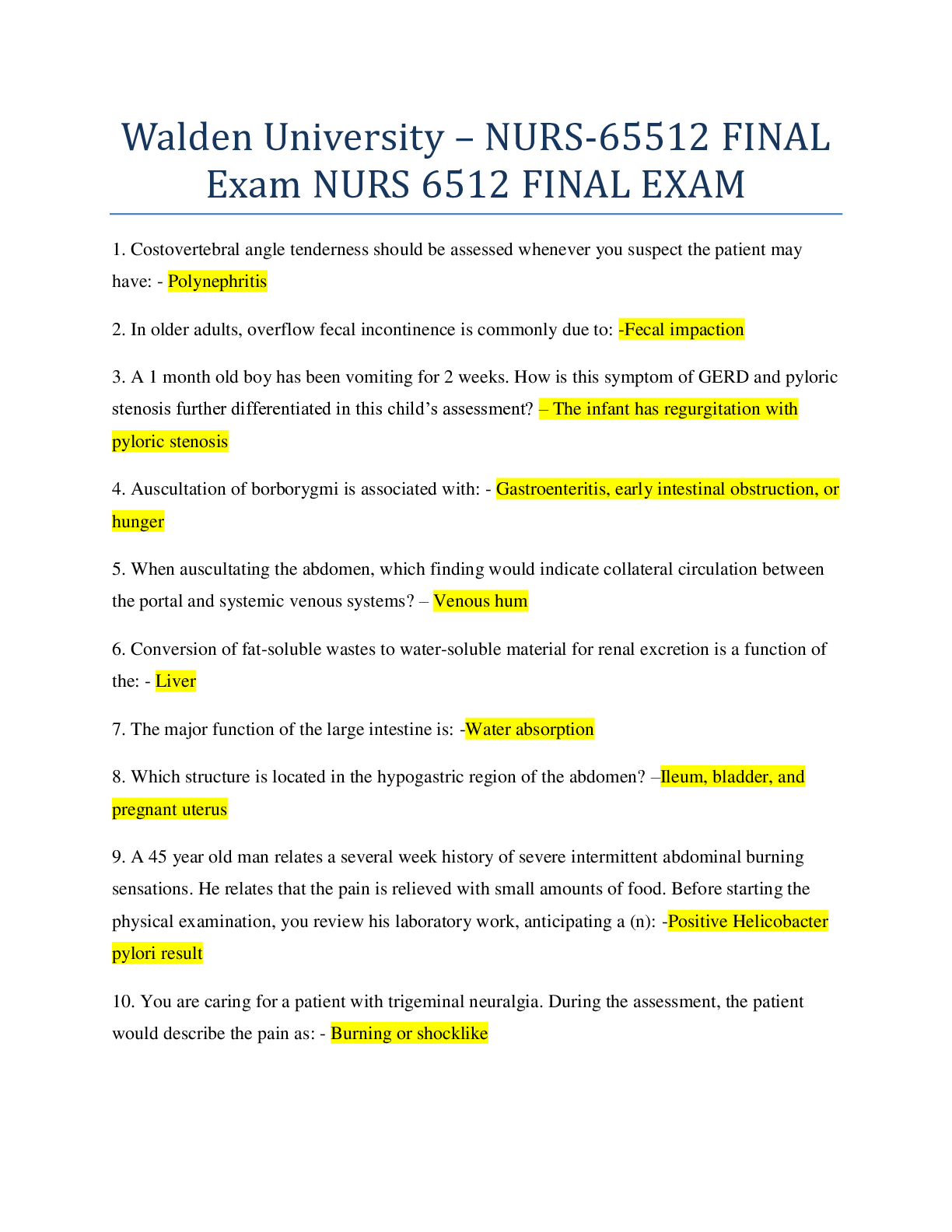
Walden University – NURS-65512 FINAL Exam NURS 6512 FINAL EXAM. 116 Questions and Answers.
1. Costovertebral angle tenderness should be assessed whenever you suspect the patient may have: - 2. In older adults, overflow fecal incontinence is commonly due to: 3. A 1 month old boy has been v...
By Kirsch , Uploaded: Jun 01, 2020
$18
*NURSING> EXAM > AGNP BOARD EXAM QUESTIONS Assessment Eye, Ear, Nose and Throat (166 Questions and Answer)Latest 2022 Version 100% Accurate (All)
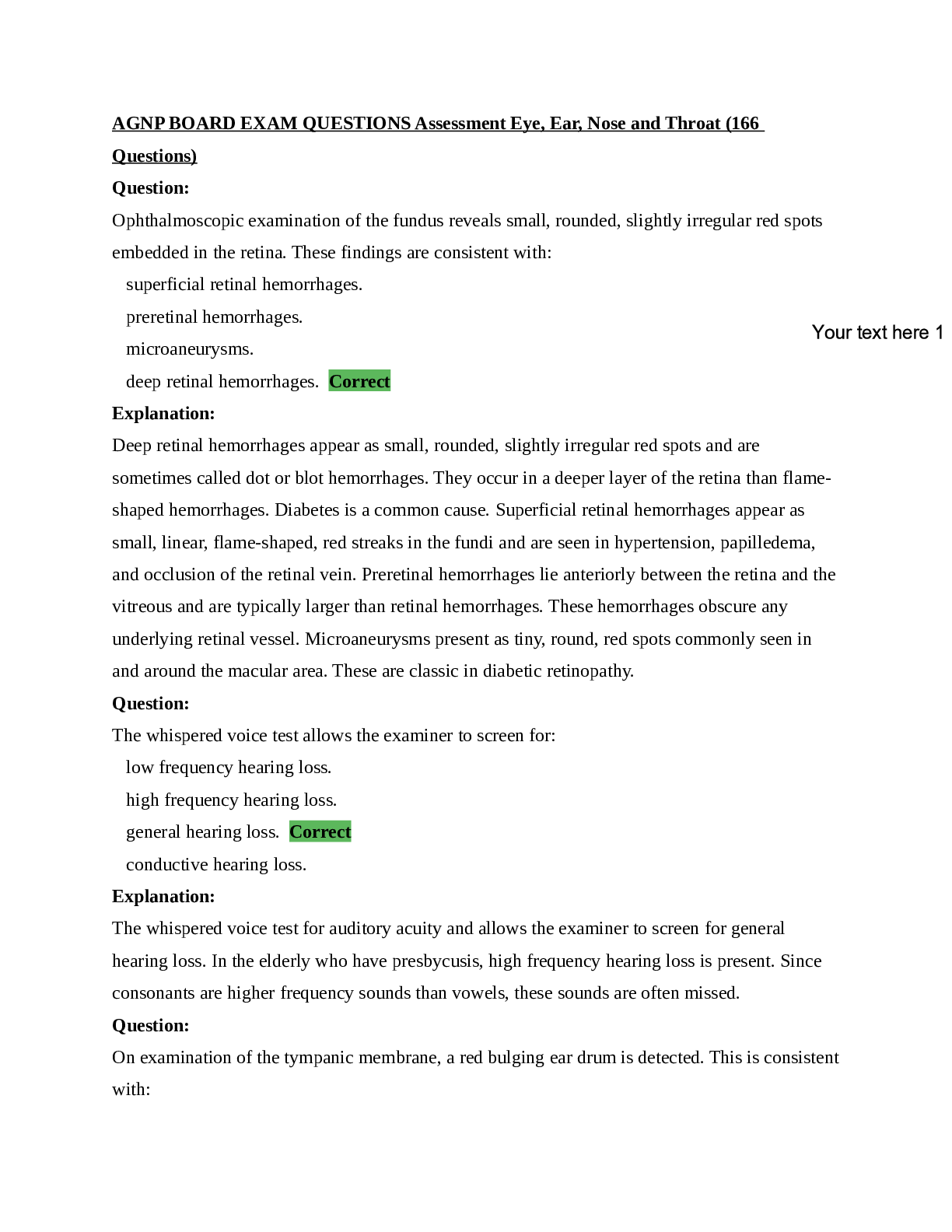
AGNP BOARD EXAM QUESTIONS Assessment Eye, Ear, Nose and Throat (166 Questions and Answer)Latest 2022 Version 100% Accurate
AGNP BOARD EXAM QUESTIONS Assessment Eye, Ear, Nose and Throat (166 Questions and Answer)Latest 2022 Version 100% Accurate
By Aimhigh , Uploaded: Jul 22, 2022
$13
*NURSING> EXAM > NRNP6645 Midterm Exam - Week 6 Questions And Answers 2021 (WALDEN UNIVERSITY) (All)
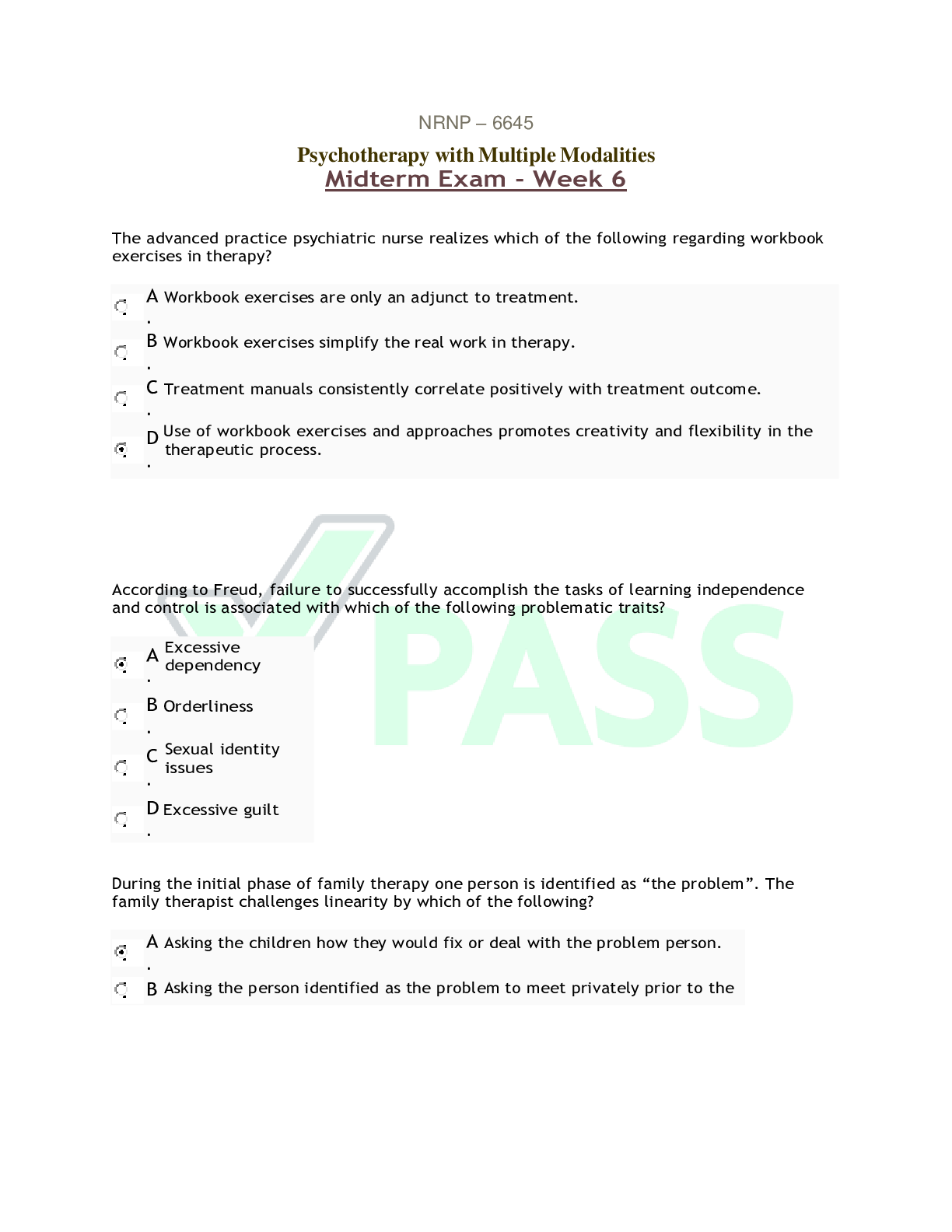
NRNP6645 Midterm Exam - Week 6 Questions And Answers 2021 (WALDEN UNIVERSITY)
NRNP6645 Midterm Exam - Week 6 Questions And Answers 2021 (WALDEN UNIVERSITY)
By Ellen Ronald , Uploaded: Jul 18, 2022
$30
*NURSING> EXAM > ATI TEAS 6 Questions And Answers - English Solution/TOP SCORE (All)

ATI TEAS 6 Questions And Answers - English Solution/TOP SCORE
ATI TEAS 6 Questions - English Sandra's principal reason for choosing the job was that it would be full-time and would offer benefits. Which of the following is the complete subject? A. Sandr a's prin...
By BrendaGee , Uploaded: Jul 16, 2022
$10.5
Computer Science> EXAM > MCITP 70-646 Chapters 1 - 6 questions and answers Graded A (All)
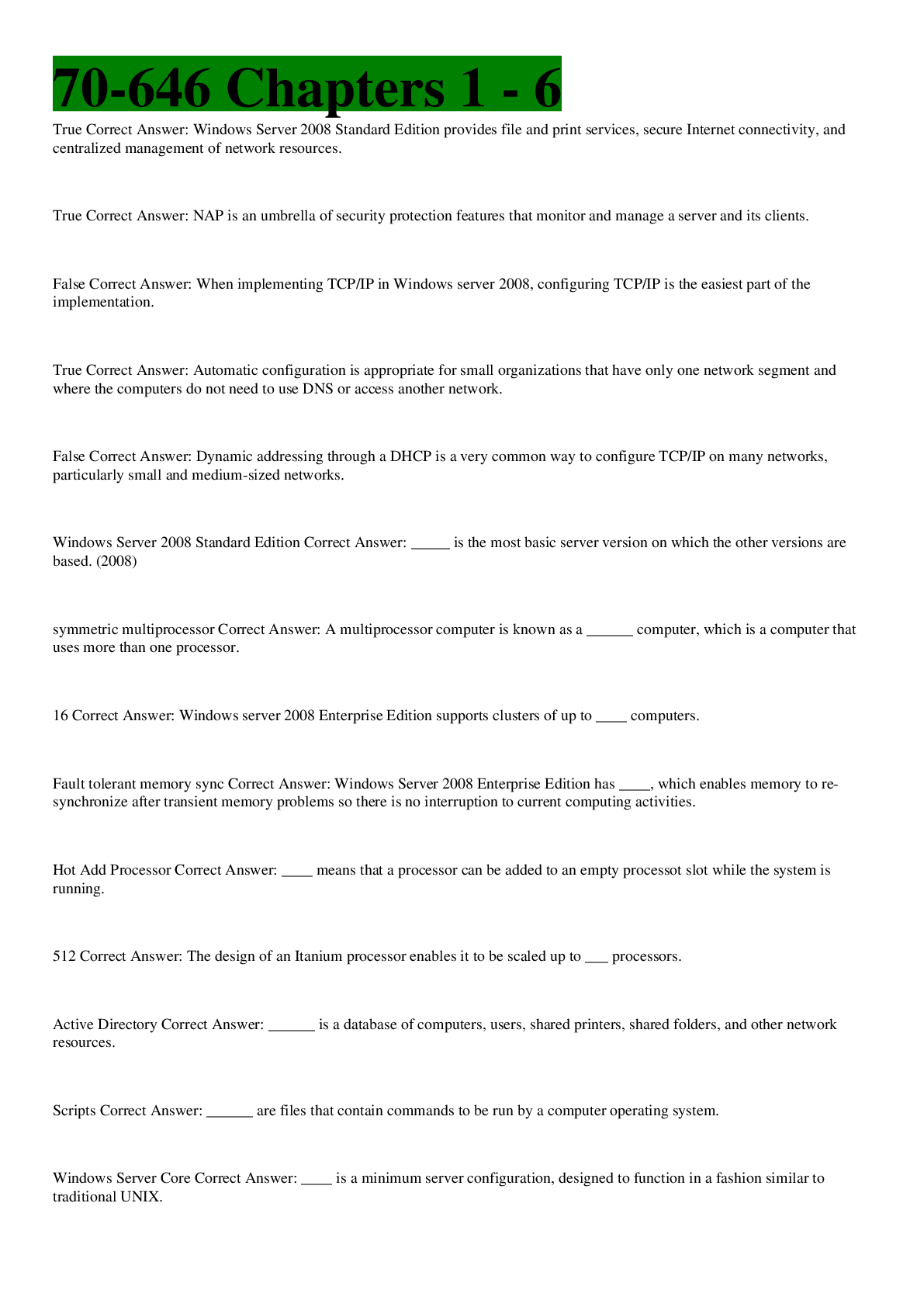
MCITP 70-646 Chapters 1 - 6 questions and answers Graded A
70-646 Chapters 1 - 6 True Correct Answer: Windows Server 2008 Standard Edition provides file and print services, secure Internet connectivity, and centralized management of network resources. Tr...
By Crum , Uploaded: Jul 12, 2022
$13
*NURSING> EXAM > Portage Learning BIOD 171 Microbiology Lecture Exam Key 1-6 Questions And Answers( Complete top Solution Rated A) (All)
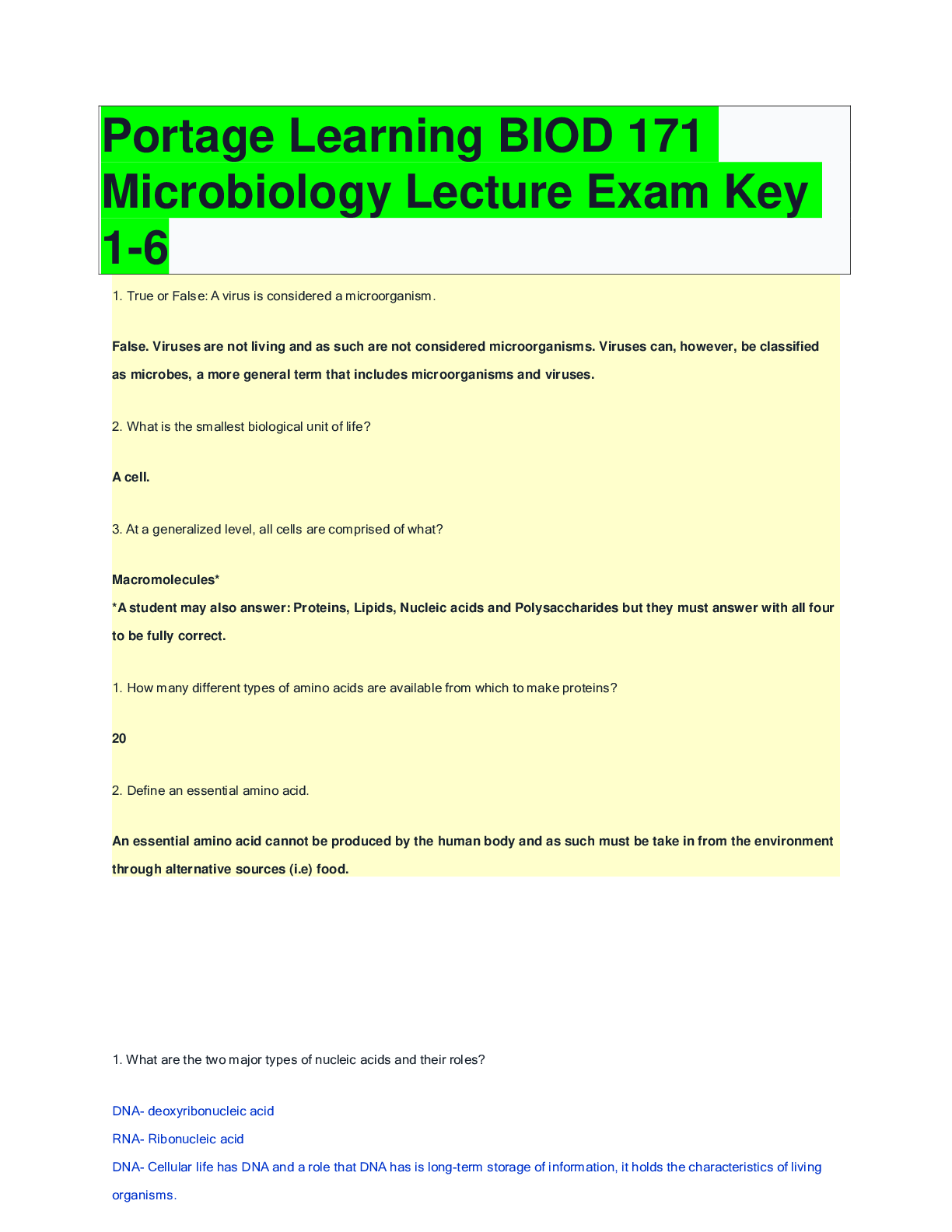
Portage Learning BIOD 171 Microbiology Lecture Exam Key 1-6 Questions And Answers( Complete top Solution Rated A)
Portage Learning BIOD 171 Microbiology Lecture Exam Key 1-6 Questions And Answers( Complete Solution Rated A)
By frankie , Uploaded: Jul 08, 2022
$10.5
*NURSING> EXAM > Portage Microbiology Lab Exam 6 Questions And Answers 2022( With Complete top Solution Rated A) (All)

Portage Microbiology Lab Exam 6 Questions And Answers 2022( With Complete top Solution Rated A)
Portage Microbiology Lab Exam 6 Questions And Answers 2022( With Complete Solution Rated A)
By frankie , Uploaded: Jul 08, 2022
$10
Health Care> EXAM > SCIENCE ATI TEAS 6 Questions And Answers (2022 Update) (All)

SCIENCE ATI TEAS 6 Questions And Answers (2022 Update)
SCIENCE ATI TEAS 6 Questions And Answers (2022 Update)
By Mariebelle , Uploaded: Jul 01, 2022
$11
*NURSING> EXAM > Portage Learning BIOD 171 Microbiology Lecture Exam Key 1-6 Questions And Answers( Complete top Solution Rated A) (All)

Portage Learning BIOD 171 Microbiology Lecture Exam Key 1-6 Questions And Answers( Complete top Solution Rated A)
Portage Learning BIOD 171 Microbiology Lecture Exam Key 1-6 Questions And Answers( Complete Solution Rated A)
By Jameson , Uploaded: Jun 29, 2022
$10
*NURSING> EXAM > Portage Microbiology Lab Exam 6 Questions And Answers 2022( With Complete top Solution Rated A) (All)

Portage Microbiology Lab Exam 6 Questions And Answers 2022( With Complete top Solution Rated A)
Portage Microbiology Lab Exam 6 Questions And Answers 2022( With Complete Solution Rated A)
By Jameson , Uploaded: Jun 29, 2022
$10
Document information
Connected school, study & course
About the document
Uploaded On
Apr 06, 2021
Number of pages
7
Written in
Additional information
This document has been written for:
Uploaded
Apr 06, 2021
Downloads
0
Views
87






